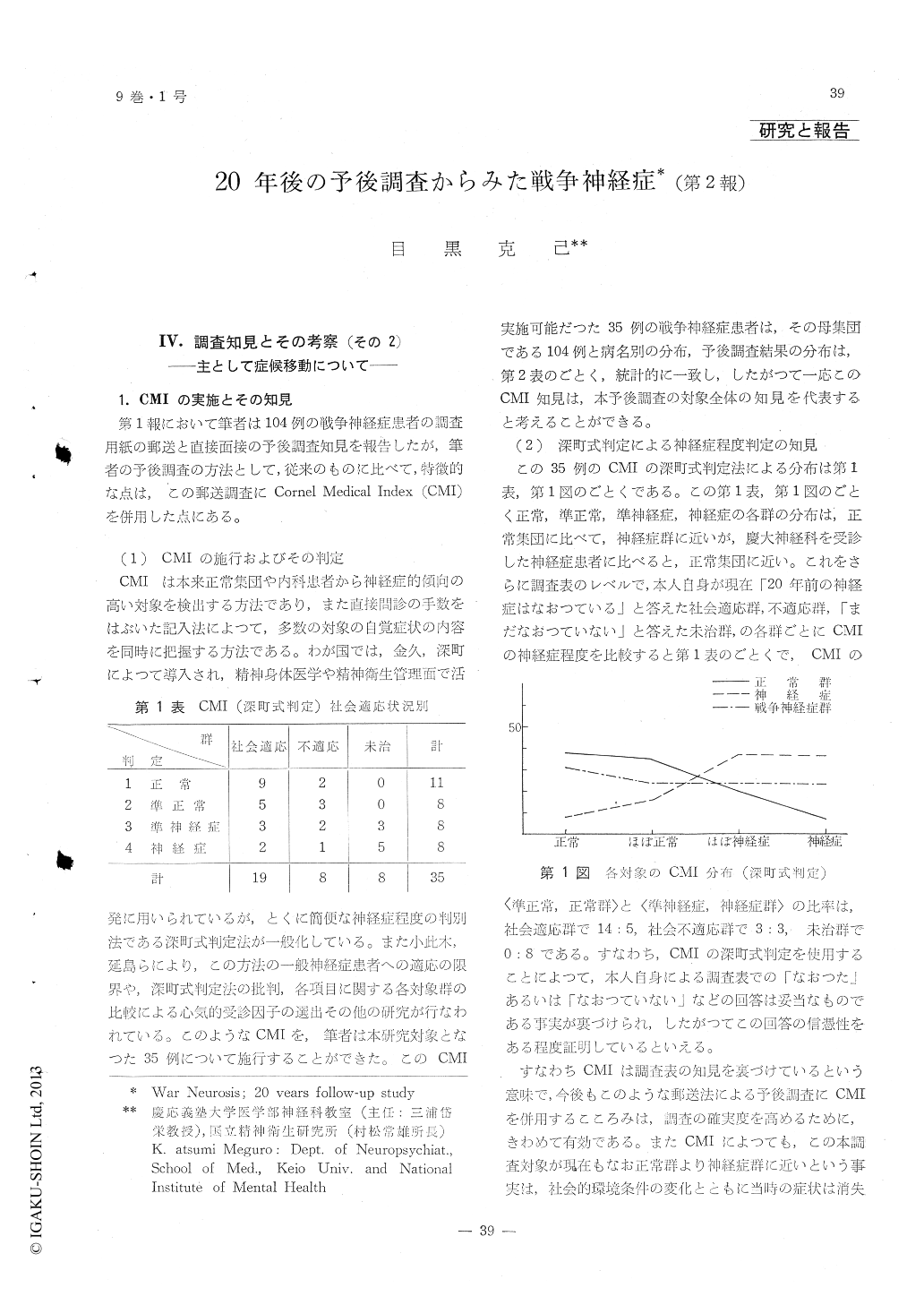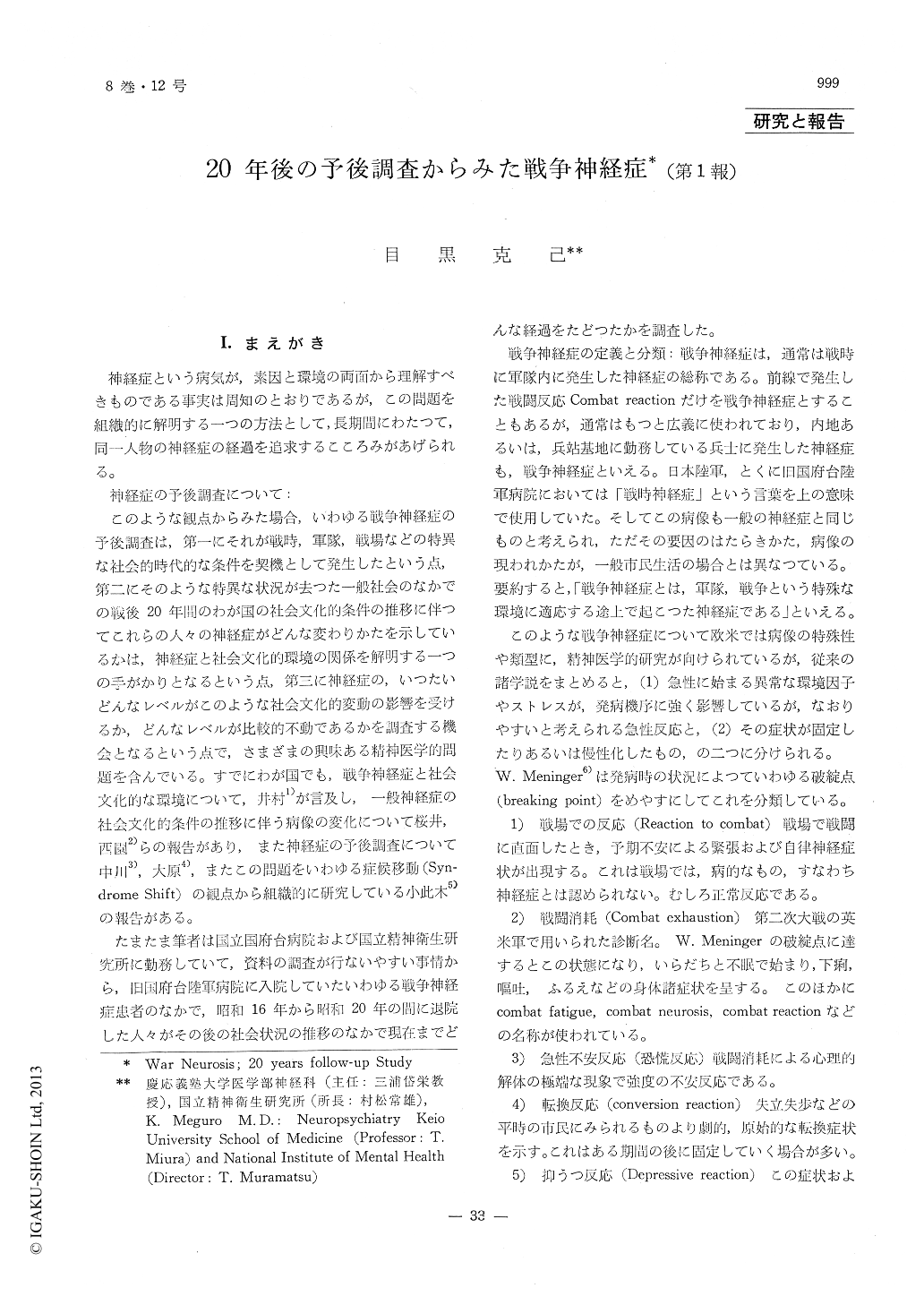7 0 0 0 OA 戦争神経症
- 著者
- 目黒 克己
- 出版者
- 一般社団法人 国立医療学会
- 雑誌
- 医療 (ISSN:00211699)
- 巻号頁・発行日
- vol.21, no.2, pp.176-180, 1967-02-20 (Released:2011-10-19)
- 参考文献数
- 12
War neurosis is also called neurosis during the war, It is the general term of neurosis which has appeared in the army during the war.Total number of neuropsychiatric patients who entered in Kondodai Military Hospital between 1938 to 1945 was 10, 454, Concerning the rate of each disease, we found 54.4% in hysteria, 33.5% in neurasthenia and 12.1% in psychogenic reaction.The percentage of hysteria during the sencond World War was 54.4% in Japan, 45.1% in U. S. S. R. and 18% in U. S. A. The rate of hysteria in the United States armed force during the first World War was 30%.Speaking about the prognosis of war neurosis in our country after 20 years, 25% of them have not recovered as yet. In the group of this kind we find that the primitive reactions disappeared, and the type of illness moved to the symptoms of disturbance of the autonomic nervous systems in every case.
1 0 0 0 戦争神経症
- 著者
- 目黒 克己
- 出版者
- 一般社団法人 国立医療学会
- 雑誌
- 医療
- 巻号頁・発行日
- vol.21, no.2, pp.176-180, 1967
War neurosis is also called neurosis during the war, It is the general term of neurosis which has appeared in the army during the war.<br>Total number of neuropsychiatric patients who entered in Kondodai Military Hospital between 1938 to 1945 was 10, 454, Concerning the rate of each disease, we found 54.4% in hysteria, 33.5% in neurasthenia and 12.1% in psychogenic reaction.<br>The percentage of hysteria during the sencond World War was 54.4% in Japan, 45.1% in U. S. S. R. and 18% in U. S. A. The rate of hysteria in the United States armed force during the first World War was 30%.<br>Speaking about the prognosis of war neurosis in our country after 20 years, 25% of them have not recovered as yet. In the group of this kind we find that the primitive reactions disappeared, and the type of illness moved to the symptoms of disturbance of the autonomic nervous systems in every case.
1 0 0 0 20年後の予後調査からみた戦争神経症(第2報)
- 著者
- 目黒 克己
- 出版者
- 医学書院
- 雑誌
- 精神医学 (ISSN:04881281)
- 巻号頁・発行日
- vol.9, no.1, pp.39-42, 1967-01-15
Ⅳ.調査知見とその考察(その2)——主として症候移動について——1.CMIの実施とその知見 第1報において筆者は104例の戦争神経症患者の調査用紙の郵送と直接面接の予後調査知見を報告したが,筆者の予後調査の方法として,従来のものに比べて,特徴的な点は,との郵送調査にCornel Medical Index (CMI)を併用した点にある。
1 0 0 0 20年後の予後調査からみた戦争神経症(第1報)
- 著者
- 目黒 克己
- 出版者
- 医学書院
- 雑誌
- 精神医学 (ISSN:04881281)
- 巻号頁・発行日
- vol.8, no.12, pp.999-1007, 1966-12-15
I.まえがき 神経症という病気が,素因と環境の両面から理解すべきものである事実は周知のとおりであるが,この問題を組織的に解明する一つの方法として,長期間にわたつて,同一人物の神経症の経過を追求するこころみがあげられる。 神経症の予後調査について: このような観点からみた場合,いわゆる戦争神経症の予後調査は,第一にそれが戦時,軍隊,戦場などの特異な社会的時代的な条件を契機として発生したという点,第二にそのような特異な状況が去つた一般社会のなかでの戦後20年間のわが国の社会文化的条件の推移に伴つてこれらの人々の神経症がどんな変わりかたを示しているかは,神経症と社会文化的環境の関係を解明する一つの手がかりとなるという点,第三に神経症の,いつたいどんなレベルがこのような社会文化的変動の影響を受けるか,どんなレベルが比較的不動であるかを調査する機会となるという点で,さまざまの興味ある精神医学的問題を含んでいる。すでにわが国でも,戦争神経症と社会文化的な環境について,井村1)が言及し,一般神経症の社会文化的条件の推移に伴う病像の変化について桜井,西園2)らの報告があり,また神経症の予後調査について中川3),大原4),またこの問題をいわゆる症候移動(Syn-drome Shift)の観点から組織的に研究している小此木5)の報告がある。

